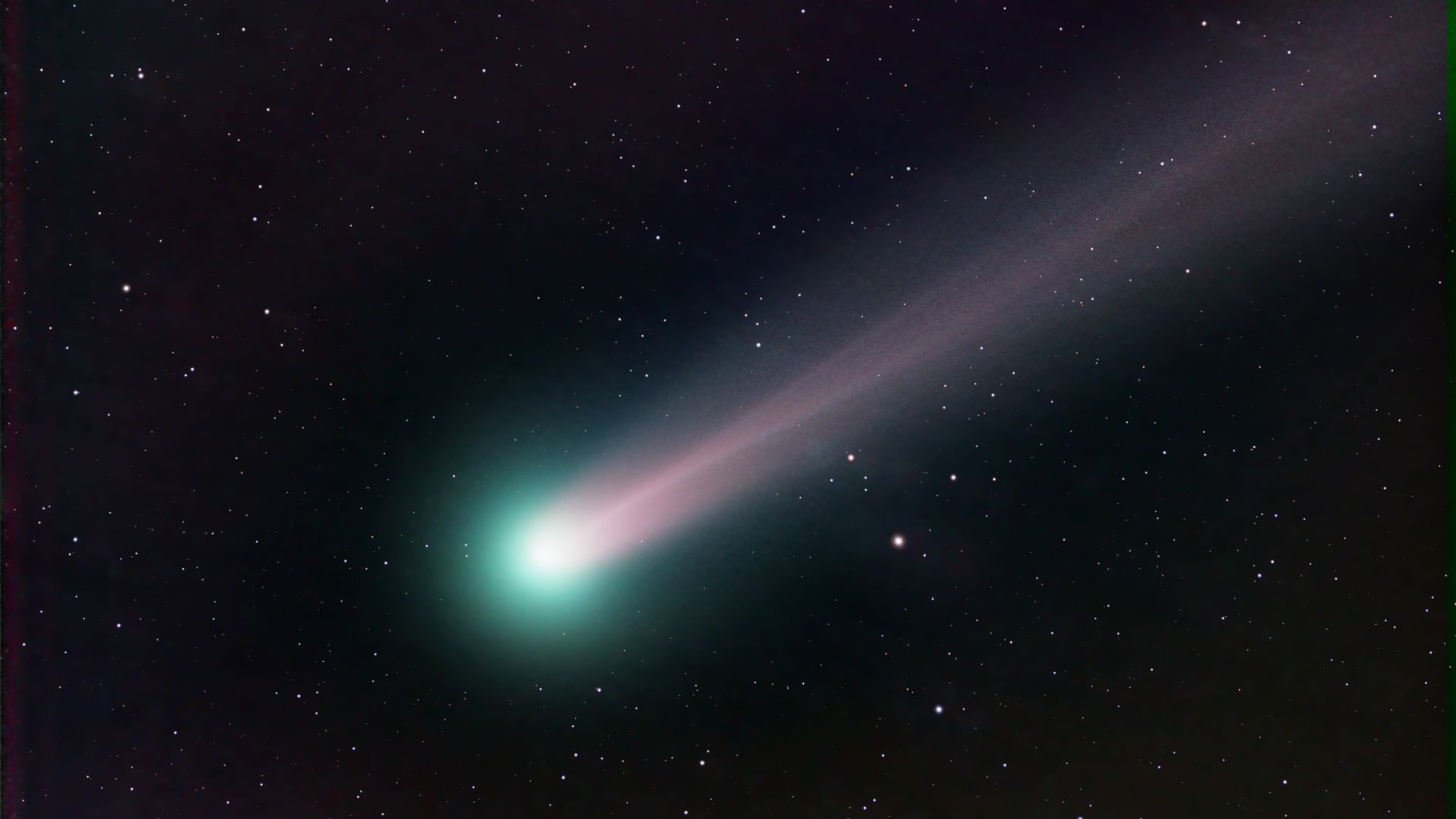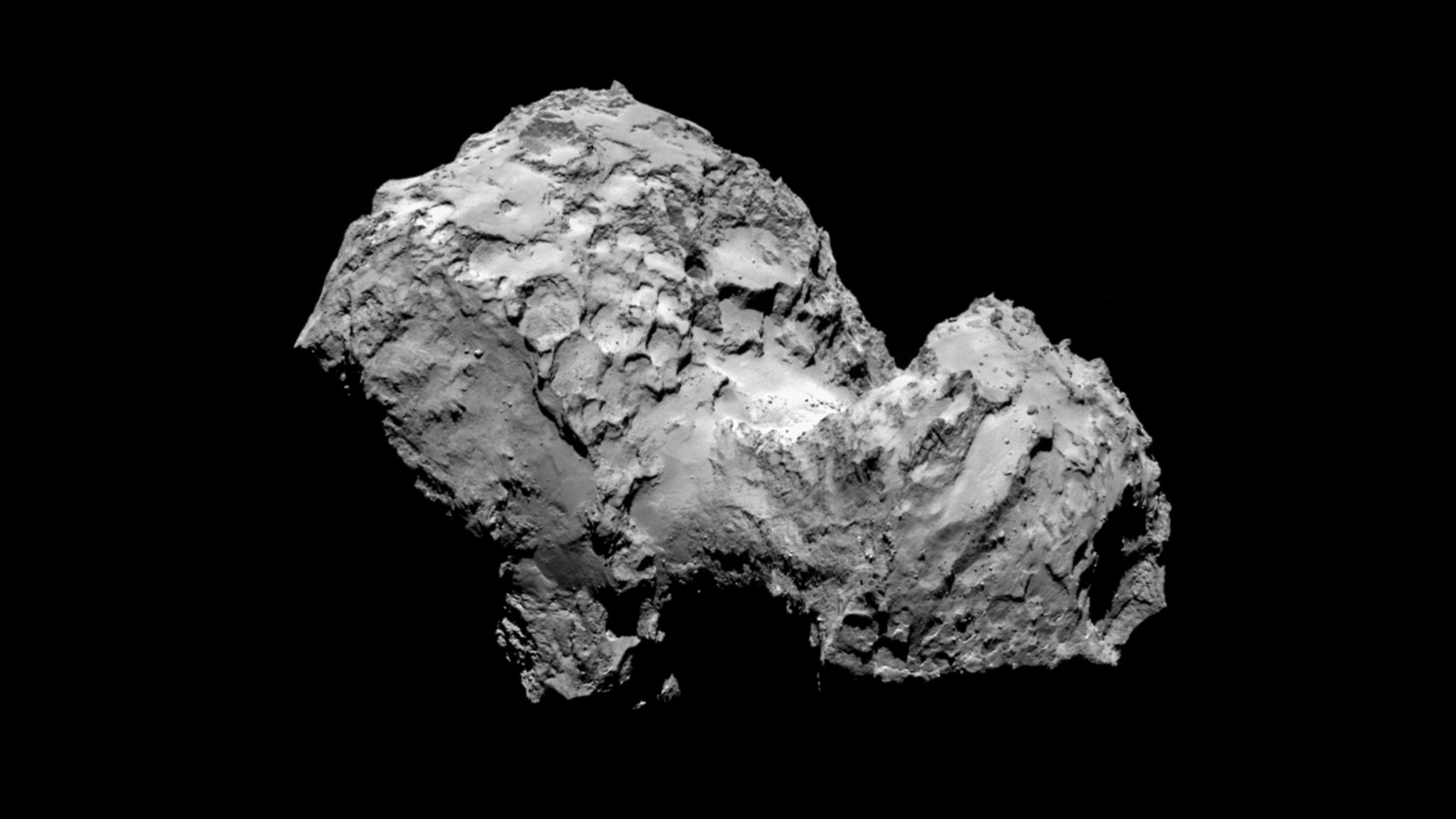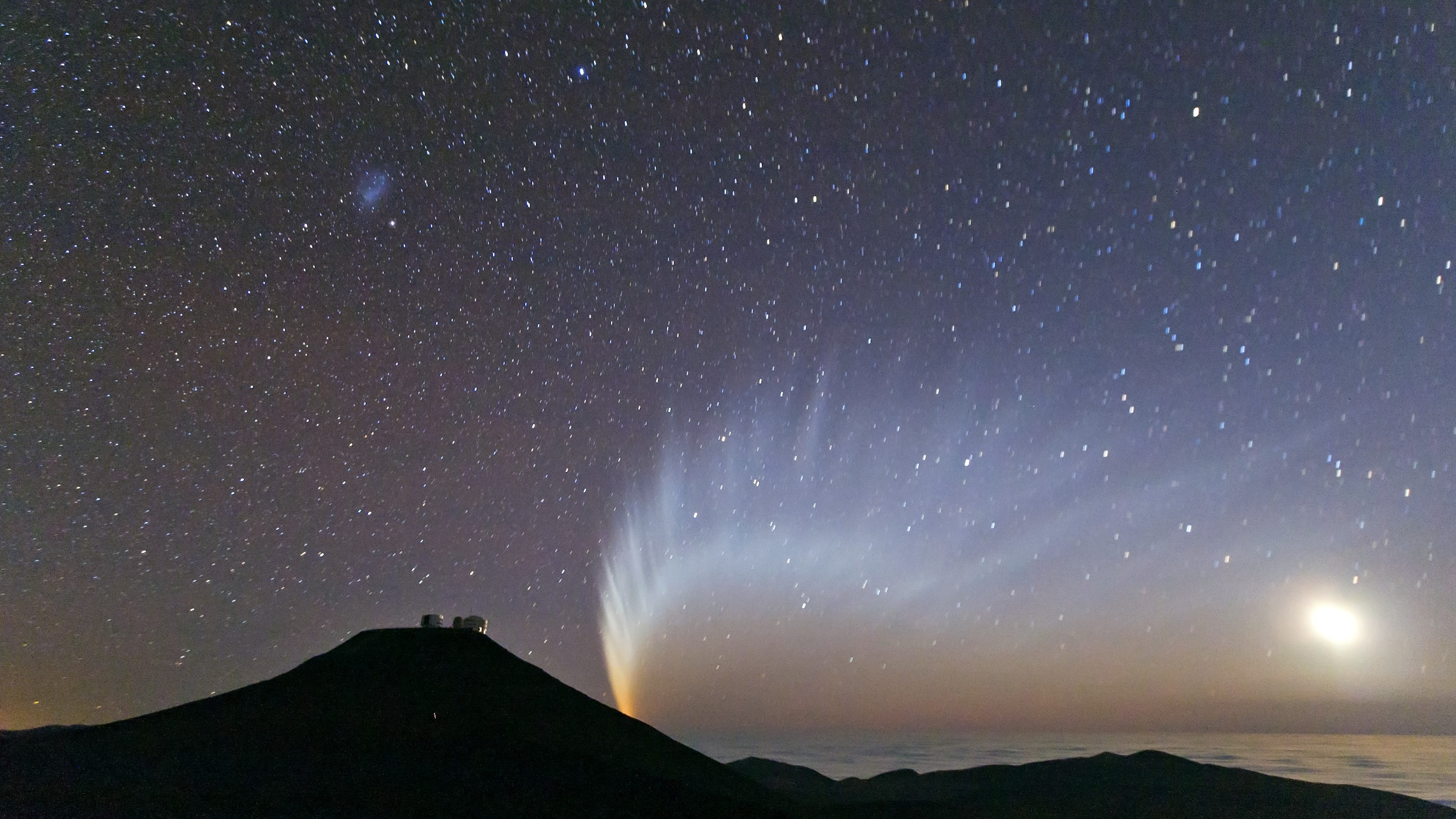Comets, those icy wanderers of the solar system, have captivated humanity for centuries. Planning a trip to Vietnam and looking up at the night sky? Maybe you will be lucky enough to see one. If you’re curious about these celestial travelers and wondering “How Fast Does A Comet Travel?”, SIXT.VN is here to shed light on their fascinating speeds and other amazing facts. Let’s explore the cosmos and then come back down to Earth to plan your Vietnam adventure! Unlock unforgettable travel experiences with SIXT.VN, your trusted partner for Vietnam adventures.
1. Understanding Comets: Icy Travelers of Space
Comets are celestial bodies composed of ice, dust, and rock. These “dirty snowballs” or “icy dirtballs”, remnants from the solar system’s formation 4.6 billion years ago, journey around the sun in elongated orbits.
As stated by NASA, a comet is mostly frozen gases, rocks, and dust left over from the formation of the solar system about 4.6 billion years ago.
 The comet appears to have a glowing green/blue nucleus and a long pink/white tail stretch off in one direction as it streaks across a star-studded sky.
The comet appears to have a glowing green/blue nucleus and a long pink/white tail stretch off in one direction as it streaks across a star-studded sky.
What are the Main Components of a Comet?
According to ESA, comets mainly consist of a nucleus, coma, hydrogen envelope, dust tail, and plasma tail.
- Nucleus: The solid, icy core of a comet, typically a few kilometers in diameter.
- Coma: A cloud of gas and dust that forms around the nucleus as it approaches the sun and the ice sublimates.
- Hydrogen Envelope: A vast, tenuous region of hydrogen gas surrounding the coma.
- Dust Tail: A tail composed of small dust particles pushed away from the comet by sunlight.
- Ion Tail (Plasma Tail): A tail of ionized gas that interacts with the solar wind, pointing directly away from the sun.
2. How Fast Does A Comet Travel? The Speed of Cometary Motion
The speed of a comet varies significantly depending on its distance from the sun. When far away, comets move relatively slowly. However, as they approach the sun, their speed increases dramatically due to the sun’s gravitational pull.
What is the typical range of comet speeds?
Comets can travel at speeds ranging from 0.5 kilometers per second (1,100 mph) to as fast as 70 kilometers per second (156,600 mph) when nearing the sun.
What factors influence a comet’s speed?
- Distance from the Sun: The closer a comet is to the sun, the faster it travels due to the increased gravitational force.
- Orbit Shape: Comets with highly elliptical orbits experience greater speed variations.
- Comet Size and Composition: Larger comets with more mass may have slightly different orbital characteristics.
3. Why Do Comets Speed Up as They Approach the Sun?
Comets accelerate as they get closer to the sun due to the sun’s gravitational pull, which follows Kepler’s Second Law of Planetary Motion.
Kepler’s Second Law of Planetary Motion
According to NASA, Kepler’s Second Law states that a line joining a planet and the sun sweeps out equal areas during equal intervals of time. This means that a comet moves faster when it is closer to the sun and slower when it is farther away.
Conservation of Energy
The total energy of a comet (the sum of its kinetic and potential energy) remains constant. As a comet approaches the sun, its potential energy decreases, and its kinetic energy increases, resulting in higher speed.
4. Famous Comets and Their Speeds
Several famous comets have been observed and studied extensively, providing valuable data about their speeds and orbital characteristics.
Halley’s Comet
Halley’s Comet, perhaps the most well-known comet, orbits the sun approximately every 76 years.
What is the speed of Halley’s Comet at its fastest?
At its closest approach to the sun (perihelion), Halley’s Comet reaches a speed of about 54 kilometers per second (120,700 mph).
Comet Hale-Bopp
Comet Hale-Bopp, visible to the naked eye for a record 18 months in 1997, was another notable comet.
How fast did Comet Hale-Bopp travel at perihelion?
Comet Hale-Bopp reached a speed of approximately 44 kilometers per second (98,400 mph) at its closest approach to the sun.
Comet C/2022 E3 (ZTF)
Comet C/2022 E3 (ZTF), a recent visitor to our inner solar system, garnered attention for its green hue.
What was the speed of Comet C/2022 E3 (ZTF) during its closest approach to Earth?
Comet C/2022 E3 (ZTF) reached an estimated speed of about 58 kilometers per second (130,000 mph) at perihelion.
5. How Comets Influence Meteor Showers on Earth
Comets play a significant role in creating meteor showers, providing stunning celestial displays for observers on Earth.
How do comets create meteor showers?
As comets orbit the sun, they shed debris consisting of dust and small particles. When Earth passes through these debris trails, the particles enter our atmosphere, burning up and creating the streaks of light we see as meteors.
Notable meteor showers associated with comets
- Perseids: Associated with Comet Swift-Tuttle, occurring annually in August.
- Leonids: Linked to Comet Tempel-Tuttle, peaking about every 33 years.
- Orionids: Associated with Halley’s Comet, visible in October.
6. Observing Comets: Tips for Amateur Astronomers
Observing comets can be a rewarding experience for amateur astronomers. Here are some tips to help you spot these celestial wanderers.
What equipment is needed to view comets?
Binoculars or a small telescope can significantly enhance your ability to see comets. Dark skies away from city lights are also essential for optimal viewing.
Where can you find information on upcoming comets?
Websites like in-the-sky.org offer databases and finder charts to help locate comets.
Tips for photographing comets
- Use a camera with manual settings and a wide aperture lens.
- Set a high ISO and use a tripod to stabilize the camera.
- Experiment with different exposure times to capture the comet’s tail.
7. Space Missions to Comets: Unveiling Their Secrets
Several space missions have been dedicated to studying comets up close, providing invaluable insights into their composition and behavior.
Notable comet missions
- Deep Impact: NASA’s mission collided an impactor into Comet Tempel 1, revealing its interior composition.
- Stardust: NASA’s mission returned samples from Comet Wild 2, discovering amino acids.
- Rosetta: ESA’s mission orbited Comet 67P/Churyumov-Gerasimenko, deploying the Philae lander.
- Comet Interceptor: ESA’s upcoming mission will intercept an as-yet-undiscovered comet, capturing snapshots from different angles.
What have we learned from these missions?
These missions have revealed that comets contain organic molecules, have diverse compositions, and may play a role in delivering water and other essential elements to planets.
8. Comets in History and Culture
Throughout history, comets have been viewed with a mix of awe and apprehension, often considered omens of significant events.
How have comets been perceived in different cultures?
In ancient times, comets were often seen as harbingers of doom, associated with war, famine, and other calamities.
Notable historical observations of comets
- Chinese astronomers kept extensive records of comets, including Halley’s Comet, dating back to 240 B.C.
- Tycho Brahe’s observations in 1577 revealed that comets traveled beyond the moon.
- Isaac Newton discovered that comets move in elliptical orbits around the sun.
9. Main-Belt Comets: A Source of Water for Terrestrial Planets
Recently, scientists have discovered comets in the main asteroid belt, known as main-belt comets.
What are main-belt comets?
Main-belt comets are icy bodies located in the asteroid belt between Mars and Jupiter, which may be a key source of water for the inner terrestrial planets.
How do main-belt comets contribute to the water content of inner planets?
These comets may have delivered water and other volatile compounds to Earth and other inner planets through impacts and other processes.
10. The Oort Cloud: The Distant Home of Comets
The Oort Cloud is a vast, spherical region located far beyond the Kuiper Belt, believed to be the origin of many long-period comets.
What is the Oort Cloud?
According to NASA, the Oort Cloud is a theoretical cloud of icy debris located at the edge of the solar system.
How does the Oort Cloud contribute to the population of comets?
The Oort Cloud is thought to contain billions of comets, which are occasionally perturbed by passing stars, sending them into the inner solar system.
 A rocky comet nucleus against a black background.
A rocky comet nucleus against a black background.
11. The Kuiper Belt: A Region of Icy Objects
The Kuiper Belt is a region beyond Neptune’s orbit containing numerous icy objects, including short-period comets.
What is the Kuiper Belt?
According to NASA, the Kuiper Belt is a region beyond Neptune’s orbit that contains many icy objects.
How does the Kuiper Belt contribute to the population of comets?
The Kuiper Belt is the source of many short-period comets, which are pulled into the inner solar system by gravitational interactions with the outer planets.
12. Comet C/2014 UN271 (Bernardinelli-Bernstein): The Largest Comet Ever Seen
Comet C/2014 UN271 (Bernardinelli-Bernstein) is the largest comet ever discovered, with a diameter of 62 to 124 miles (100 km to 200 km).
What is the size of Comet C/2014 UN271 (Bernardinelli-Bernstein)?
Astronomers estimate that this icy body has a diameter of 62 miles to 124 miles (100 km to 200 km), making it about 10 times wider than a typical comet.
When will Comet C/2014 UN271 (Bernardinelli-Bernstein) make its closest approach to Earth?
The comet will make its closest approach to our planet in 2031 but will remain at quite a distance even then.
13. The Dust and Ion Tails of Comets
Comets have two main types of tails: dust tails and ion tails. These tails are shaped by sunlight and the solar wind.
How are dust tails formed?
Dust tails are formed when sunlight pushes small particles in the coma into an elongated curved path.
How are ion tails formed?
Ion tails are formed from electrically charged molecules of gas that interact with the solar wind, always pointing directly away from the sun.
14. Sun-Grazing Comets: Close Encounters with the Sun
Sun-grazing comets are comets that pass extremely close to the sun, often breaking up and evaporating.
What happens to sun-grazing comets?
Some sun-grazing comets smash right into the sun or get so close that they break up and evaporate due to the intense heat and gravitational forces.
Notable sun-grazing comets
The Sungrazer Project has identified thousands of sun-grazing comets, providing valuable data about their behavior.
15. The Composition of Comets: Dirty Snowballs
Comets are often referred to as “dirty snowballs” or “icy dirtballs” due to their composition of ice, dust, and rock.
What is the typical composition of a comet?
Comets typically consist of frozen water, carbon dioxide, ammonia, methane, and other volatile compounds, as well as dust and rock particles.
How does the composition of comets affect their behavior?
The composition of comets determines how they behave as they approach the sun, including the rate of sublimation, the formation of the coma and tails, and their overall brightness.
16. Single-Apparition Comets: Visitors from Afar
Single-apparition comets are comets that are not bound to the sun and have orbits that take them out of the solar system after a single pass.
Where do single-apparition comets come from?
Single-apparition comets are thought to come from the Oort Cloud, which get slung inward by the gravitational pull of passing stars.
Why are single-apparition comets rare?
Single-apparition comets are rare because their orbits are not stable, and they are often ejected from the solar system after a single pass.
17. Missions to Specific Comets: Deep Dive into Cometary Science
Various missions have targeted specific comets to study their unique characteristics and behavior.
Deep Impact mission to Comet Tempel 1
NASA’s Deep Impact mission collided an impactor into Comet Tempel 1 in 2005, revealing the interior composition and structure of the nucleus.
Rosetta mission to Comet 67P/Churyumov-Gerasimenko
ESA’s Rosetta mission orbited Comet 67P/Churyumov-Gerasimenko from 2014 to 2016, deploying the Philae lander and studying the comet’s surface, composition, and behavior.
18. The Impact of Comets on Early Earth
Comets are believed to have played a role in the delivery of water and organic molecules to early Earth, contributing to the conditions necessary for life.
How did comets deliver water to early Earth?
Comets may have delivered water to early Earth through impacts, with the water contained in their icy bodies.
How did comets contribute to the origin of life?
Comets may have contributed to the origin of life by delivering organic molecules, such as amino acids, to early Earth.
19. The Future of Comet Research
Comet research continues to be an active area of study, with ongoing and planned missions aimed at further understanding these fascinating celestial objects.
Planned comet missions
ESA’s Comet Interceptor mission is due to launch in 2029 and will intercept an as-yet-undiscovered comet, capturing snapshots from different angles.
Future research directions
Future research directions include studying the composition and structure of cometary nuclei, investigating the role of comets in delivering water and organic molecules to planets, and assessing the potential threat of comet impacts.
20. Amazing Photos of Comets: Visual Wonders of the Solar System
Comets offer stunning visual displays as they journey through the solar system, capturing the imagination of astronomers and the public alike.
Notable comet photos
- Comet NEOWISE: Captured in 2020, this comet displayed a bright tail and was visible to the naked eye.
- Comet Hale-Bopp: Visible for a record 18 months in 1997, this comet was notable for its bright appearance and long tail.
- Comet C/2022 E3 (ZTF): This comet garnered attention for its green hue and relatively close approach to Earth.
Tips for photographing comets
- Use a camera with manual settings and a wide aperture lens.
- Set a high ISO and use a tripod to stabilize the camera.
- Experiment with different exposure times to capture the comet’s tail.
FAQ: Frequently Asked Questions About Comets
Have more questions about comets? Here are some frequently asked questions and their answers.
How fast does a comet travel?
Comets can travel at speeds ranging from 0.5 kilometers per second (1,100 mph) to as fast as 70 kilometers per second (156,600 mph) when nearing the sun.
What are comets made of?
Comets are made of ice, dust, and rock, often referred to as “dirty snowballs” or “icy dirtballs.”
Where do comets come from?
Most comets come from the Oort Cloud and the Kuiper Belt, located far beyond the orbit of Neptune.
How do comets get their names?
Comets are generally named after their discoverer or the mission that discovered them.
Why do comets have tails?
Comet tails are formed when sunlight and the solar wind interact with the comet’s nucleus, causing it to release gas and dust.
How often do comets visit the inner solar system?
Some comets visit the inner solar system regularly, while others may only appear once every few thousand or million years.
Can comets pose a threat to Earth?
While the risk of a comet impact is low, some researchers are concerned about the potential threat of comet strikes.
What is the difference between a comet and an asteroid?
Comets are icy bodies that release gas and dust as they approach the sun, while asteroids are rocky or metallic bodies that do not exhibit this behavior.
How do comets influence meteor showers?
Comets leave a trail of debris behind them that can lead to meteor showers on Earth when Earth passes through these debris trails.
What is the largest comet ever discovered?
Comet C/2014 UN271 (Bernardinelli-Bernstein) is the largest comet ever discovered, with a diameter of 62 miles to 124 miles (100 km to 200 km).
 Comet McNaught behind Mount Paranal in January 2007.
Comet McNaught behind Mount Paranal in January 2007.
Ready to Explore Vietnam?
Now that you’ve journeyed through the cosmos and learned about the speed of comets, it’s time to plan your Earthly adventure! SIXT.VN offers a range of services to make your trip to Vietnam seamless and unforgettable:
- Airport Transfers: Start your trip stress-free with our reliable and comfortable airport transfer services.
- Hotel Booking: Choose from a variety of hotels to suit your budget and preferences.
- Tours: Explore the beauty and culture of Hanoi with our expertly guided tours.
- Flight Booking: Find the best deals on flights to Vietnam with our convenient booking service.
Don’t let the challenges of planning a trip hold you back. SIXT.VN is here to provide convenient, reliable, and high-quality travel services. Contact us today and let us help you create the perfect Vietnam adventure!
Address: 260 Cau Giay, Hanoi, Vietnam
Hotline/Whatsapp: +84 986 244 358
Website: SIXT.VN
Let SIXT.VN take care of the details, so you can focus on making memories that will last a lifetime. Discover Vietnam with us and experience the best of this amazing country!



